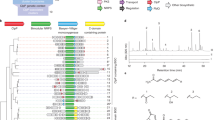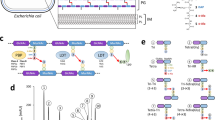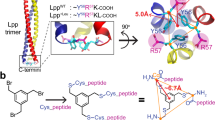Abstract
One of the most significant hurdles to developing new chemical probes of biological systems and new drugs to treat disease is that of understanding the mechanism of action of small molecules discovered with cell-based small-molecule screening. Here we have assembled an ordered, high-expression clone set of all of the essential genes from Escherichia coli and used it to systematically screen for suppressors of growth inhibitory compounds. Using this chemical genomic approach, we demonstrate that the targets of well-known antibiotics can be identified as high copy suppressors of chemical lethality. This approach led to the discovery of MAC13243, a molecule that belongs to a new chemical class and that has a unique mechanism and promising activity against multidrug-resistant Pseudomonas aeruginosa. We show that MAC13243 inhibits the function of the LolA protein and represents a new chemical probe of lipoprotein targeting in bacteria with promise as an antibacterial lead with Gram-negative selectivity.
This is a preview of subscription content, access via your institution
Access options
Subscribe to this journal
Receive 12 print issues and online access
$259.00 per year
only $21.58 per issue
Buy this article
- Purchase on Springer Link
- Instant access to full article PDF
Prices may be subject to local taxes which are calculated during checkout




Similar content being viewed by others
References
Ford, C.W., Zurenko, G.E. & Barbachyn, M.R. The discovery of linezolid, the first oxazolidinone antibacterial agent. Curr. Drug Targets Infect. Disord. 1, 181–199 (2001).
LaPlante, K.L. & Rybak, M.J. Daptomycin - a novel antibiotic against Gram-positive pathogens. Expert Opin. Pharmacother. 5, 2321–2331 (2004).
Brown, E.D. & Wright, G.D. New targets and screening approaches in antimicrobial drug discovery. Chem. Rev. 105, 759–774 (2005).
Payne, D.J., Gwynn, M.N., Holmes, D.J. & Pompliano, D.L. Drugs for bad bugs: confronting the challenges of antibacterial discovery. Nat. Rev. Drug Discov. 6, 29–40 (2007).
Wang, J. et al. Platensimycin is a selective FabF inhibitor with potent antibiotic properties. Nature 441, 358–361 (2006).
Xu, D. et al. Genome-wide fitness test and mechanism-of-action studies of inhibitory compounds in Candida albicans. PLoS Pathog. 3, e92 (2007).
Giaever, G. et al. Genomic profiling of drug sensitivities via induced haploinsufficiency. Nat. Genet. 21, 278–283 (1999).
Lum, P.Y. et al. Discovering modes of action for therapeutic compounds using a genome-wide screen of yeast heterozygotes. Cell 116, 121–137 (2004).
Parsons, A.B. et al. Integration of chemical-genetic and genetic interaction data links bioactive compounds to cellular target pathways. Nat. Biotechnol. 22, 62–69 (2004).
Baetz, K. et al. Yeast genome-wide drug-induced haploinsufficiency screen to determine drug mode of action. Proc. Natl. Acad. Sci. USA 101, 4525–4530 (2004).
Li, X. et al. Multicopy suppressors for novel antibacterial compounds reveal targets and drug efflux susceptibility. Chem. Biol. 11, 1423–1430 (2004).
Zgurskaya, H.I. & Nikaido, H. Multidrug resistance mechanisms: drug efflux across two membranes. Mol. Microbiol. 37, 219–225 (2000).
Tokuda, H. & Matsuyama, S. Sorting of lipoproteins to the outer membrane in E. coli. Biochim. Biophys. Acta 1694, IN1–IN9 (2004).
Casadaban, M.J. & Cohen, S.N. Analysis of gene control signals by DNA fusion and cloning in Escherichia coli. J. Mol. Biol. 138, 179–207 (1980).
Kitagawa, M. et al. Complete set of ORF clones of Escherichia coli ASKA library (a complete set of E. coli K-12 ORF archive): unique resources for biological research. DNA Res. 12, 291–299 (2005).
Chalker, A.F. & Lunsford, R.D. Rational identification of new antibacterial drug targets that are essential for viability using a genomics-based approach. Pharmacol. Ther. 95, 1–20 (2002).
Brown, E.D., Vivas, E.I., Walsh, C.T. & Kolter, R. MurA (MurZ), the enzyme that catalyzes the first committed step in peptidoglycan biosynthesis, is essential in Escherichia coli. J. Bacteriol. 177, 4194–4197 (1995).
Kuzuyama, T., Shimizu, T., Takahashi, S. & Seto, H. Fosmidomycin, a specific inhibitor of 1-dexoy-D-xylulose 5-phosphate reductoisomerase in the nonmevalonate pathway for terpenoid biosynthesis. Tetrahedr. Lett. 39, 7913–7916 (1998).
Rood, J.I., Laird, A.J. & Williams, J.W. Cloning of the Escherichia coli K-12 dihydrofolate reductase gene following mu-mediated transposition. Gene 8, 255–265 (1980).
Hitchings, G.H. & Burchall, J.J. Inhibition of folate biosynthesis and function as a basis for chemotherapy. Adv. Enzymol. Relat. Areas Mol. Biol. 27, 417–468 (1965).
Neuhaus, F.C. & Lynch, J.L. The enzymatic synthesis of D-alanyl-D-alanine. 3. On the inhibition of D-alanyl-D-alanine synthetase by the antibiotic D-cycloserine. Biochemistry 3, 471–480 (1964).
Lambert, M.P. & Neuhaus, F.C. Mechanism of D-cycloserine action: alanine racemase from Escherichia coli W. J. Bacteriol. 110, 978–987 (1972).
Baba, T. et al. Construction of Escherichia coli K-12 in-frame, single-gene knockout mutants: the Keio collection. Mol. Syst. Biol. 2, 2006.0008 (2006).
Koronakis, V., Eswaran, J. & Hughes, C. Structure and function of TolC: the bacterial exit duct for proteins and drugs. Annu. Rev. Biochem. 73, 467–489 (2004).
Mayer, M. & Meyer, B. Characterization of ligand binding by saturation transfer difference NMR spectroscopy. Angew. Chem. Int. Ed. 38, 1784–1788 (1999).
Dalvit, C., Fogliatto, G., Stewart, A., Veronesi, M. & Stockman, B. WaterLOGSY as a method for primary NMR screening: practical aspects and range of applicability. J. Biomol. NMR 21, 349–359 (2001).
Elkins, C.A. & Nikaido, H. Substrate specificity of the RND-type multidrug efflux pumps AcrB and AcrD of Escherichia coli is determined predominantly by two large periplasmic loops. J. Bacteriol. 184, 6490–6498 (2002).
Tajima, T., Yokota, N., Matsuyama, S. & Tokuda, H. Genetic analyses of the in vivo function of LolA, a periplasmic chaperone involved in the outer membrane localization of Escherichia coli lipoproteins. FEBS Lett. 439, 51–54 (1998).
Rice, L.B. Unmet medical needs in antibacterial therapy. Biochem. Pharmacol. 71, 991–995 (2006).
Matsuyama, S., Fujita, Y. & Mizushima, S. SecD is involved in the release of translocated secretory proteins from the cytoplasmic membrane of Escherichia coli. EMBO J. 12, 265–270 (1993).
Matsuyama, S., Tajima, T. & Tokuda, H. A novel periplasmic carrier protein involved in the sorting and transport of Escherichia coli lipoproteins destined for the outer membrane. EMBO J. 14, 3365–3372 (1995).
Meyer, B. et al. Saturation transfer difference NMR spectroscopy for identifying ligand epitopes and binding specificities. Ernst Schering Res. Found. Workshop 44, 149–167 (2004).
National Committee on Clinical Laboratory Standards. Methods for Dilution Antimicrobial Susceptibility Tests for Bacteria that Grow Aerobically (National Committee on Clinical Laboratory Standards, Wayne, Pennsylvania, USA, 2000).
Acknowledgements
We thank B. Wanner and H. Mori of Purdue University and the Nara Institute, respectively, for providing the ordered genomic library (ASKA library) used in these studies and for inspiring discussion. We thank H. Zgurskaya at University of Oklahoma for the polyclonal antibodies against TolC, we thank D. Andrews at McMaster University for the YidC antibodies and we thank G. Wright at McMaster University for the clinical isolates of P. aeruginosa. This work was supported by an operating grant from the Canadian Institutes of Health Research (MOP-81330) and by a Canada Research Chair award to E.D.B.
Author information
Authors and Affiliations
Contributions
R.P. designed and performed the high-expression array experiments, lipoprotein targeting studies and antibacterial activity determinations for MAC13243 and analogs and co-wrote the manuscript. S.Z. conducted the efflux susceptibility tests, analyzed the SAR data and the activity of MAC13243 against the pseudomonal isolates and co-wrote the manuscript. C.B. performed the suppression analysis of MAC13243 by high copy LolA and analyzed the SAR data. D.A.G., J.L. and E.A. performed the synthesis and characterization of MAC13243 and analogs under the guidance of F.A.C. R.D. performed the NMR spectroscopy studies of MAC13243 and LolA under the guidance of G.M. F.A.C. and G.M. co-wrote the manuscript. E.D.B. conceived and oversaw the project and co-wrote the manuscript.
Corresponding author
Supplementary information
Supplementary Text and Figures
Supplementary Figures 1–4, Supplementary Tables 1 and 2, and Supplementary Methods (PDF 854 kb)
Rights and permissions
About this article
Cite this article
Pathania, R., Zlitni, S., Barker, C. et al. Chemical genomics in Escherichia coli identifies an inhibitor of bacterial lipoprotein targeting. Nat Chem Biol 5, 849–856 (2009). https://doi.org/10.1038/nchembio.221
Received:
Accepted:
Published:
Issue Date:
DOI: https://doi.org/10.1038/nchembio.221
This article is cited by
-
Tackling the outer membrane: facilitating compound entry into Gram-negative bacterial pathogens
npj Antimicrobials and Resistance (2023)
-
Deep learning-guided discovery of an antibiotic targeting Acinetobacter baumannii
Nature Chemical Biology (2023)
-
Insights on recent approaches in drug discovery strategies and untapped drug targets against drug resistance
Future Journal of Pharmaceutical Sciences (2021)
-
Details of hydrophobic entanglement between small molecules and Braun’s lipoprotein within the cavity of the bacterial chaperone LolA
Scientific Reports (2019)
-
Chemical-genetic profiling reveals limited cross-resistance between antimicrobial peptides with different modes of action
Nature Communications (2019)



